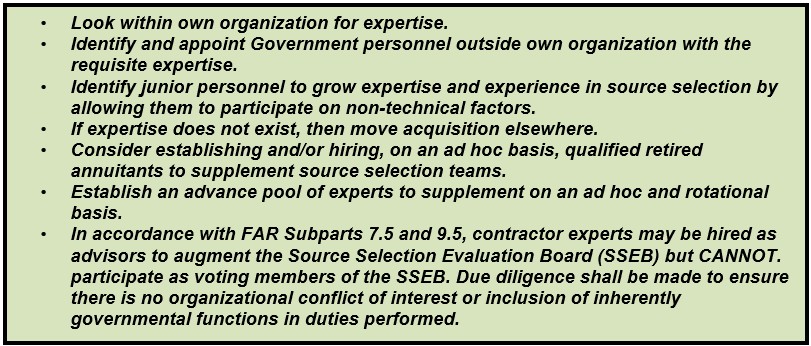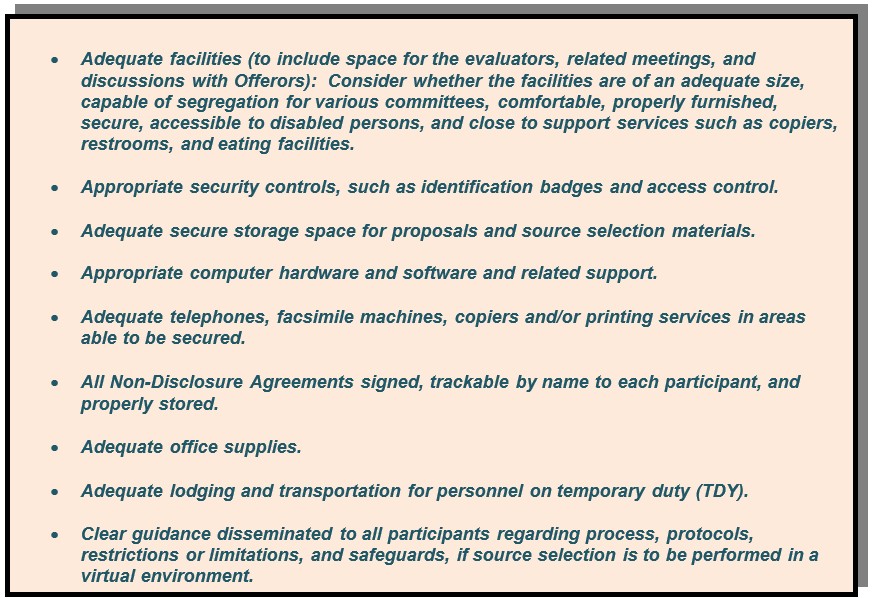CHAPTER 1 PURPOSE, ROLES, AND RESPONSIBILITIES
1.1 Purpose
The Army Source Selection Supplement (AS3) implements and supplements the mandatory Department of Defense (DoD) Source Selection Procedures to establish consistent policies and procedures for Army source selections. The Federal Acquisition Regulation (FAR) and its supplements (Defense FAR Supplement (DFARS), DFARS Procedures, Guidance, and Information (PGI), Army FAR Supplement (AFARS) and the AFARS PGI) prescribe the general policies governing these acquisitions.
1.2 Applicability and Waivers
The AS3 applies to best value, negotiated, competitive source selections with an estimated value greater than $10 million, and may also be used as guidance in all other acquisitions. DoD Source Selection Procedures: https://www.acq.osd.mil/dpap/policy/policyvault/USA000740-22-DPC.pdf, Paragraph 1.2, content for applicability and waivers also applies to Army waiver procedures.
The AS3 is not a stand-alone document and shall be used in conjunction with FAR Part 15, DFARS and DFARS PGI Subpart 215, AFARS and AFARS PGI Subpart 5115 and the DoD Source Selection Procedures. Any conflicts shall be resolved through the Office of the Deputy Assistant Secretary of the Army (Procurement) (ODASA(P)), Policy Directorate, mailbox usarmy.pentagon.hqda-asa-alt.mbx.office-of-the-dasa-p@army.mil.
Any request for waiver of the DoD Source Selection Procedures shall be submitted by the cognizant Senior Contracting Official (SCO), through their Head of the Contracting Activity (HCA), to the DASA(P), Attn: Policy Directorate (SAAL-PP). ODASA(P) will process all waivers as follows:
For solicitations valued at $1 billion or more, waivers may only be approved with the express, written permission of the Director, Defense Pricing, Contracting, and Acquisition Policy (DPCAP).
For solicitations valued below $1 billion, waivers must be approved by the DASA(P).
1.3 Best Value Continuum
Subjective Tradeoff. Use of subjective tradeoff is appropriate for most Army source selections. See Appendix B for more information. (Reference DoD Source Selection Procedures https://www.acq.osd.mil/dpap/policy/policyvault/USA000740-22-DPC.pdf , Section 1.3.1.3)
Value Adjusted Total Evaluated Price (VATEP). Use of VATEP may be most suitable for procuring developmental items when the government can determine the value (or worth) of “better performance” and quantify it in the Request for Proposal (RFP). See Appendix B for more information. (Reference DoD Source Selection Procedures 1.3.1.4)
1.4 Source Selection Team Roles & Responsibilities
Source selection is a multi-disciplined team effort. The Source Selection Team (SST) should include representatives from appropriate functional areas such as contracting, small business, technical, logistics, cost/price, legal, and program management. User organizations should also be represented.
The success of any source selection is usually determined by the personnel involved at all levels, and their degree of active participation. Likewise, the Source Selection Authority (SSA), with assistance from the SCO, will ensure the appointment of personnel with the requisite skills, expertise, and experience to ensure the success of the source selection, to include members appointed to the Source Selection Advisory Council (SSAC).
The SCO is responsible for determining the capability of the organization to effectively resource the SST as set forth in the hierarchy of source selection expertise below (See Figure 1-1). In the event the SCO determines the required expertise is not obtainable, the HCA will be consulted. If the HCA concurs the appropriate resources are still unavailable, the DASA(P) will be notified and will assist in providing resources from other contracting activities or assign the procurement to another contracting activity for execution.

Figure 1-1: Hierarchy of Source Selection Expertise
The size and composition of the SST will vary depending upon the requirements of each acquisition. For example, major hardware acquisitions frequently involve requirements impacting various organizations from across the Army (or from other services on joint-service programs). In such cases, and when forming the SST, SSEB Factor/Subfactor teams should include evaluator representation from each major requirements organization. These evaluators should be assigned to the evaluation criteria associated with their specific area of requirements and expertise. Inclusion of technical evaluators who are subject matter experts on the requirement(s) being evaluated is essential to a successful evaluation process providing fair/accurate assessment of the proposals, and absolutely critical where joint-service and/or multiple functional requirements are involved.
Whether the team is large or small, it should be structured to ensure teamwork, unity of purpose, and allow for appropriate open communication among the team members throughout the process. This will facilitate a comprehensive evaluation and selection of the best value proposal.
Key Components of the SST
For source selections with a total estimated value of $100M or more, the SST shall consist of the SSA, a SSAC, and an SSEB. Each of these SST entities has distinct and separate functions (See Figure 1-2).

Figure 1-2: SST Responsibilities
NOTE: Source selections using LPTA methodology do NOT require the SSAC or require a SSAC Report be prepared.
The SSEB is usually comprised of multiple groups of evaluators who are responsible for evaluating specific areas of the proposal against the RFP requirements. Additionally, legal counsel, small business professionals, cost/price, and technical experts may also serve as SST advisors. The precise structure of the SSEB is a matter within the SSA’s discretion.
The information below supplements the Roles and Responsibilities found in the DoD Source Selection Procedures (See paragraph 1.4).
The SSA.
Appointment. The AFARS 5115.303 provides the policy on SSA appointments.
o All appointed SSAs are considered procurement officials and are subject to the associated statutory / regulatory rules.
o Once appointed, the SSA cannot further delegate their SSA authorities.
o For source selections exceeding $100M, the SSA is other than the PCO.
Ensures the Source Selection Plan (SSP) and evaluation criteria are consistent with the requirements of the solicitation and applicable regulations.
NOTE: The identity of the SSA shall be considered procurement sensitive and shall not be disclosed to anyone who has not signed a non-disclosure agreement for that RFP / acquisition.
The Procuring Contracting Officer (PCO).
(No Supplemental Army Guidance.)
The SSAC.
The SSAC will consist of senior government personnel and may include representation from the cognizant contracting office and legal office.
For Acquisition Category I/II source selections involving requirements organizations from across the Army (or from other services on joint-service programs), the SSAC must include representation from all significant requirements organizations. The SSAC representatives must be at an organization / grade level commensurate with the other members of the SSAC, usually military 0-6/GS-15 or higher.
The SSEB.
The SSEB Chairperson.
o Ensures the SSEB members understand the evaluation criteria and establishes a uniform approach to the evaluation and rating effort. Seeks to build consensus among the SSEB members.
o Isolates policy issues and major questions requiring decision by the SSA.
o Relieves and replaces SSEB members from assignment only in the event of a demonstrated emergency or other appropriate cause.
o Arranges for the SSEB members to work compensatory time, when necessary, authorized, and approved.
o Arranges for the needed administrative staff at the evaluation work site.
The SSEB Members.
o Prepare the evaluation notices (ENs).
o Briefs the SSAC/SSA (as requested) and responds to comments / instructions from the SSAC/SSA.
Legal Counsel.
Non-disclosure agreements (NDAs) will not be requested or required of HQDA Office of General Counsel (OGC) attorneys.
Other Advisors.
(No Supplemental Army Guidance.)
Program Manager (PM) / Requiring Activity (RA).
(No Supplemental Army Guidance.)
Small Business Team.
Assists requirements office and PCO with Market Research during planning and throughout the various acquisition phases.
Assists in shaping Acquisition Strategy in support of small businesses when applicable.
Provides review of draft and final documents prior to release to potential offerors.
Tools.
Army’s Virtual Source Selection Advisory Team (VSSAT) Tile is accessible through Army’s Knowledge Management Portal Procurement.Army.Mil (PAM) Source selection tile (https://armyeitaas.sharepoint-mil.us/sites/ASA-ALT-PAM-ProcProc/SitePages/SourceSelection.aspx).
Administrative Support.
Each acquisition will vary in terms of the administrative support requirements.
Figure 1-3 on the following page contains a checklist of some important requirements common to many acquisitions.

Figure 1-3: Administrative Support Requirements